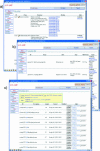ACLAME: a CLAssification of Mobile genetic Elements
- PMID: 14681355
- PMCID: PMC308818
- DOI: 10.1093/nar/gkh084
ACLAME: a CLAssification of Mobile genetic Elements
Abstract
The ACLAME database (http://aclame.ulb.ac.be) is a collection and classification of prokaryotic mobile genetic elements (MGEs) from various sources, comprising all known phage genomes, plasmids and transposons. In addition to providing information on the full genomes and genetic entities, it aims to build a comprehensive classification of the functional modules of MGEs at the protein, gene and higher levels. This first version contains a comprehensive classification of 5069 proteins from 119 DNA bacteriophages into over 400 functional families. This classification was produced automatically using TRIBE-MCL, a graph-theory-based Markov clustering algorithm that uses sequence measures as input, and then manually curated. Manual curation was aided by consulting annotations available in public databases retrieved through additional sequence similarity searches using Psi-Blast and Hidden Markov Models. The database is publicly accessible and open to expert volunteers willing to participate in its curation. Its web interface allows browsing as well as querying the classification. The main objectives are to collect and organize in a rational way the complexity inherent to MGEs, to extend and improve the inadequate annotation currently associated with MGEs and to screen known genomes for the validation and discovery of new MGEs.
Figures


References
-
- de la Cruz F. and Davies,J. (2000) Horizontal gene transfer and the origin of species: lessons from bacteria. Trends Microbiol., 8, 128–133. - PubMed
-
- Gogarten J.P., Doolittle,W.F. and Lawrence,J.G. (2002) Prokaryotic evolution in light of gene transfer. Mol. Biol. Evol., 19, 2226–2238. - PubMed
-
- Lawrence J.G. (2002) Gene transfer in bacteria: speciation without species? Theor. Popul. Biol., 61, 449–460. - PubMed
-
- Parkhill J., Dougan,G., James,K.D., Thomson,N.R., Pickard,D., Wain,J., Churcher,C., Mungall,K.L., Bentley,S.D., Holden,M.T. et al. (2001) Complete genome sequence of a multiple drug resistant Salmonella enterica serovar Typhi CT18. Nature, 413, 848–852. - PubMed
Publication types
MeSH terms
LinkOut - more resources
Full Text Sources
Research Materials

